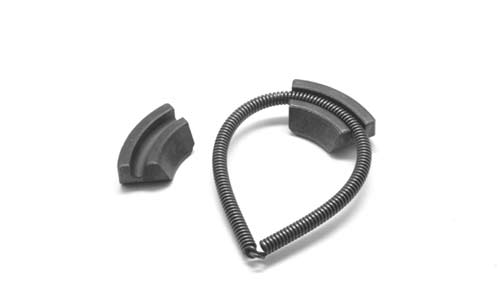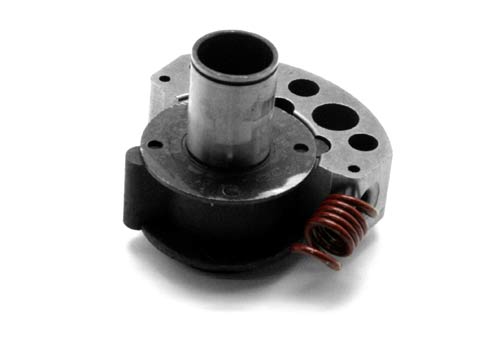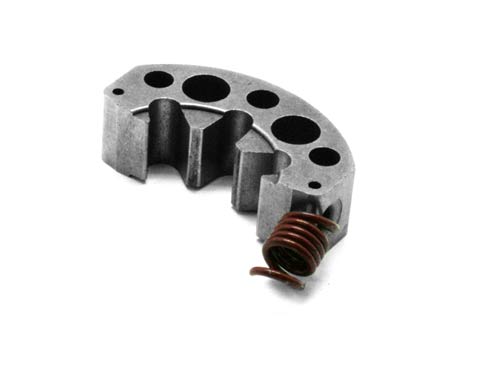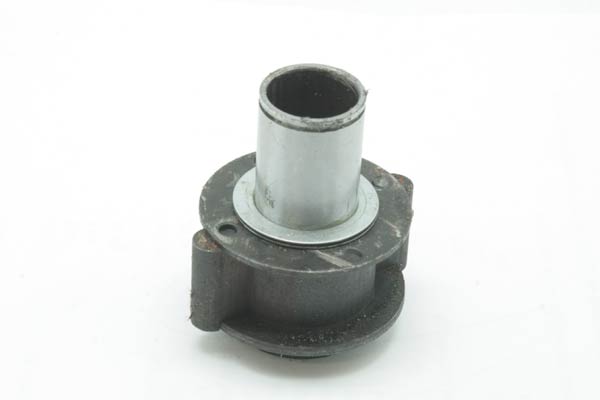The SR clutch is quite different to the GT Race clutch.
The main difference is in the way it transfers power through to the sprocket.
The SR clutch is a basic recreational system and uses about 8 shoes with one long spring holding them all in toward the centre. As the centrifugal forces act on the shoes, heat is created and the spring stretches. Just like a blacksmith, a stretched hot piece of metal does not go back to it’s original state and then it will have less tension. Less tension means it will engage at lower and lower RPM. This spring is not replaceable or adjustable. So you start with a set RPM value of about 2000rpm, and it slowly (or quickly in a race environment) will start engaging lower and lower until you can’t start the kart without it wanting to take off on you.
Home
::
GT Clutch VS SR Clutch
GT Clutch VS SR Clutch
GT Clutch VS SR Clutch
What's better? GT-Race clutch or SR Clutch?
This issue is often relative to the amount of torque being pushed through a clutch. The larger the capacity of an engine, the more of a problem this becomes. For example, a 270cc or 390cc engine will be very hard on the clutch at engagement speeds of 2000rpm due to torque. It's not the HP causing the problem, but simply the torque. Often we're asked what is the maximum amount of horsepower that can be put through an SR clutch - this can be very high - it's theoretically possible to push 30-40hp through one of those clutches, but not at the point of engagement.

Also, the SR clutch uses ‘fingers’. This type of clutch has a tendency to break the fingers due to the power being transmitted in a hurry during racing.
.jpg)
Here’s a run-down on how the SR works:
http://cutpriceracing.com.au//phpbb3/viewtopic.php?f=14&t=922
The GT Clutch is a two shoe, two spring system.
It’s really strong, and you can replace all the parts – particularly of interest are the shoes and springs. Different shoes and springs allow you to adjust the RPM engagement speed, as well as the aggressiveness of the engagement.

.jpg)
Here’s a more thorough look inside the GT Race clutch:
http://cutpriceracing.com.au//phpbb3/viewtopic.php?f=14&t=850
The springs will take a real beating, and the whole thing can get really hot before they eventually fail. If they do, it will be because they have got hot so many times they become brittle, and snap. Then you simply buy a new set (they’re really cheap) and throw them in and you’re away again!

Also, the corer has two really solid points where the shoe fits in – these don’t break off like the fingers in the SR unit.

As far as gearing is concerned, the first link about the SR clutch should answer those questions for you. Here it is again:
If you’re racing on a short track then we recommend a 12T front and a 61T rear – then move around depending on what you need.
If you divide the front into the rear (ie: 61 / 12 =) then you get a ratio – in this case approximately 5. The higher the ratio, the more acceleration and less top speed. The lower the ratio, the more top speed, but less pull out of corners (less acceleration).
So if you want to get a higher top speed (assuming you have a long enough straight to get there) then remove teeth from the rear, or add them to the front.
For example, removing 10 teeth from the rear gives us 51 / 12 = approximately 4, which is lower than 5 so it will give us more top speed, but it will be harder for the engine to get there so will limit our acceleration.
If you divide the front into the rear (ie: 61 / 12 =) then you get a ratio – in this case approximately 5. The higher the ratio, the more acceleration and less top speed. The lower the ratio, the more top speed, but less pull out of corners (less acceleration).
So if you want to get a higher top speed (assuming you have a long enough straight to get there) then remove teeth from the rear, or add them to the front.
For example, removing 10 teeth from the rear gives us 51 / 12 = approximately 4, which is lower than 5 so it will give us more top speed, but it will be harder for the engine to get there so will limit our acceleration.
Want to buy an SR Clutch? You can find them all here: http://www.cutpriceracing.com.au/store/Budget-4-stroke-Clutches/
Prefer to go with the higher performance model? Here's a link to the GT http://www.cutpriceracing.com.au/store/Race-GE-GT-Range/
Need Help?
Gift Certificates
Categories
- Shipping Upgrades
- Airboxes, Filters & Parts
- Axles & Parts
- Batteries, Chargers, Mounts
- Bearings
- Brakes & Parts
- Chassis Parts
- Cleaners
- Clutches
- Engines, Carbs & Parts
- Fuel Tanks & Parts
- Hop Up Kits
- Mower (Racing) Parts
- Plastics & Numbers
- Pocket Bike Parts
- Racing Simulator Parts & Retro Computing
- Seats
- Slider Parts & Kits
- Sprockets & Chains
- Steering Components
- Tachos, Laptimers & Gauges
- Trolleys & Stands
- Tools, Starters & Chargers
- Washers, Spacers, Springs, Nuts & Bolts
- Wheel, Tyres & Front Hubs
- Shop Soiled
Bestsellers
Special
My Shopping Cart

My Shopping Cart
Cart is empty
My Account
Free Same-Day Dispatch!
Product Updates via Facebook
Get notified about our holiday times
We Accept Paypal
Outstanding Service!
Sim Racing
Help
- FAQ - Frequently Asked Questions
- iPad and iPhone Ordering Problems
- Bank & Paypal Details
- Shipping & Trading Hours
- Contact Details
- About Us
- Condition Meter
- Terms & Conditions
- Refunds & Returns
- Privacy Policy
- GIFT VOUCHER - How to Use
- CONFIGURING Products - How To
- Do all products SHIP FREE?
- Will my item ship by Letter?
- Driver Profiles
- Testimonials
- GUIDES - CPR RT DIY Kart Assembly
- GUIDES - Engine
- GUIDES - Chassis, Steering, Axles, Brakes
- PROJECTS - Customer Submitted
- NEWS & Specials
- Sim Racing AMF
- CLUB DIRECTORY - Places to race your kart
- Locate a local Track
- Privacy Policy
- Contact Us

















